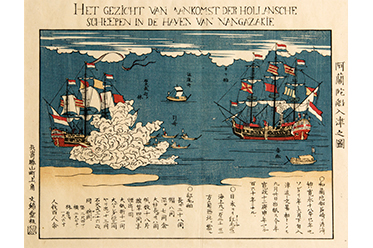 The first exhibition in Australia to present the complex artistic and cultural interaction between Europe and Asia from the sixteenth to the nineteenth centuries, Treasure Ships: Art in the Age of Spices will be on display at the Art Gallery of South Australia from June before heading to the Art Gallery of Western Australia in October 2015.
The first exhibition in Australia to present the complex artistic and cultural interaction between Europe and Asia from the sixteenth to the nineteenth centuries, Treasure Ships: Art in the Age of Spices will be on display at the Art Gallery of South Australia from June before heading to the Art Gallery of Western Australia in October 2015.
Treasure Ships: Art in the Age of Spices includes 300 outstanding and rarely seen works of ceramics, decorative arts, furniture, metalware, paintings, prints, engravings and textiles from both public and private collections in Australia, India, Portugal, Singapore and the United States.
“This landmark exhibition and its publication highlights the Gallery’s international reputation for presenting spectacular exhibitions of historical Asian and European art,” says Nick Mitzevich, Director, Art Gallery of South Australia. “Treasure Ships showcases a diverse collection of luxury objects, many of which have never previously been seen on public display in Australia.”
“This has been made possible through the extensive cooperation and support the Gallery has received from institutions, collectors and scholars in Portugal, India, Singapore, Indonesia and the United States, as well as the partnership with the Art Gallery of Western Australia.”
“The Gallery’s two curators James Bennett and Russell Kelty have worked researching the exhibition for over 3 years and their professional commitment has ensured the success of this much-anticipated exhibition.”
The works of art selected reveal how the international trade in spices and other exotic commodities inspired dialogue between Asian and European artists, a centuries old conversation whose heritage is the aesthetic globalism we know today. Europe’s infatuation with pepper, nutmeg and cloves has often been explained in terms of the necessity to preserve cooked foods in the days before the invention of refrigeration.
“This is a half-truth, which takes little account of the complex reasons the condiments of luxury and status were so avidly sought, often at great expense to human lives,” said James Bennett, Curator.
The exhibition commences with the small country of Portugal. Located on the periphery of Europe, Portugal re-mapped the West’s view of the world and created a mercantile spice empire stretching halfway around the globe during the fifteenth-sixteenth century.
In 1498 Vasco Da Gama’s small fleet became the first to reach India, landing with the famous words, ‘we come in search of Christians and spices’. Within a decade the Portuguese soldier – aristocrat Francisco de Almeida (1450-1510) had ruthlessly seized control of the Indian Ocean spice trade and established Portugal’s permanent presence in Asia that lasted four hundred years.
Treasure Ships also presents the story of exploration and trade, discovery and shipwrecks, as well as illustrating the astonishing beauty of Chinese porcelain, known as ‘white gold’, and vibrant Indian textiles created for export around the world.
There are several highlights in this exhibition including two works from the personal collection of Queen Adelaide (1792-1849) after whom the city of Adelaide was named in 1836, artefacts retrieved from the Batavia, which sank off the Western Australian coast in the seventeenth century, and a magnificent early 19th century Chinese punchbowl depicting Sydney Cove, that locates Australia within this global history.
“It is most appropriate that this exhibition should originate in Adelaide as this is the only Australian city founded on the vision of a Eurasian – the surveyor Colonel William Light (1786-1839) whose Mother was of Malaysian descent and whose remarkable self-portrait features in the exhibition,” said James Bennett.
Treasure Ships also examines the impact of the Age of Spices on the ‘discovery’ of the Australian continent and the commencement of English occupation in 1788. The colonial art of the period displays the aesthetic reverberations that continued in the Australasian region long after European ships had ceased carrying cargoes of nutmeg and cloves.
Treasure Ships: Art in the Age of Spices
Art Gallery of South Australia, North Terrace, Adelaide
Exhibition continues to 30 August 2015
Entry fees apply
Art Gallery of Western Australia, Perth Cultural Centre, Perth
Exhibition: 10 October 2015 – 31 January 2016
Entry fees apply
For more information, visit: www.artgallery.sa.gov.au or www.artgallery.wa.gov.au for details.
Image: Japan, The arrival of a Dutch ship at the port of Nagasaki in 1641 [Het gezicht van aankomst der Hollansche scheepen in de haven van nangazakie: Oranda fune nyushin no zu], 1800, Nagasaki; printed by Bunkindo, colour woodblock print on paper (nishiki-e), 30.0 x 40.0 cm, The Gwinnett Collection, Adelaide
